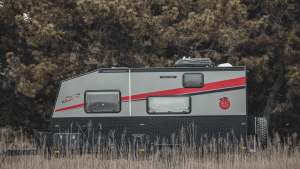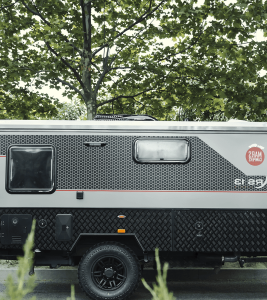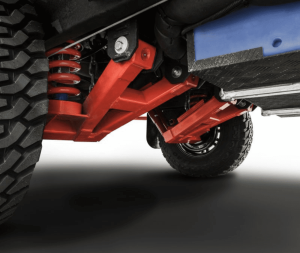Today, I will show you how to properly and safely connect a travel trailer to a truck. Throughout the process, we will talk about why we’re doing things in a very specific order, and I want to discuss some common mistakes. Let’s dive right into it.

When you raise the tongue and position the truck hitch underneath, we will start the process. Remember, before you change the pitch of an RV, the slide-out rooms should be closed, ground contact and even floating steps should be up, and ensure all your stabilizer jacks are up. Close all your doors, and one other thing: if you use X-chocks, remove them before raising your tongue. I’ve confirmed this with Lippert: changing the pitch of the RV with X-chocks installed puts rotational stress on your axles and tires that, over time, could cause damage. So, remove X-chocks if you use them, but keep your standard wheel chocks installed. Those are some of the important things to do before changing the pitch of an RV. I’ll link our full travel trailer tear-down process below if you want to see all the steps before hitching up.

So, with all of those things done, you can raise the tongue jack so it’s high enough to clear the hitch ball. Next, we’ll need to back the truck up. Do not get discouraged if you don’t get it lined up on the first or second attempt. I’ve been doing this for a long time, and there are still days where I’m making three, four, or five micro-adjustments before everything is lined up. Once you are lined up, engage your truck’s e-brake.
This next step is not a mistake. The instinct here is to drop the tongue onto the ball and get everything hitched up, but instead, connect your safety chains first. It’s very unlikely, but if the trailer starts to roll away from the truck as you change the pitch, the safety chains will stop the trailer. Cross the chains so the left side connects to the right and vice versa, and if your hitch allows, hook them from underneath instead of over the top. Crossing the chains will create an “X” or cradle. If the trailer becomes disconnected, in theory, the tongue will rest on the cradle instead of digging straight into the ground.

I’ve seen some demonstrations with unloaded boat trailers that were light enough to manually pick up as if the trailer were becoming unhitched during travel. Sometimes, the cradle caught the trailer; sometimes, it didn’t. It’s not a foolproof procedure; it depends on how your chains connect to the tongue. If they are spread apart, you will get a wider cradle. You get a narrow cradle if the chains are connected to the trailer simultaneously. All that said, I’m still crossing my chains because it’s at least giving me a chance and not hurting anything.
Also, with the hook connected from the top, you expose the locking clasp to potential road hazards. Under the right conditions, something from the road can hit this clasp, push it open, or even break it off. And with damage or no clasp, there is a slight chance that something can hit the hook and push it off the hitch.
With the hook connected from underneath, the clasp faces up and away from road hazards and is less susceptible to being struck. Additionally, the back of the hook faces the direction of travel, so it’s less likely to be knocked off the hitch. I’ve done it both ways and never had a problem, but going from underneath seems the right way. Now, the chain length is very important, but we’ll wait to talk about that until the truck is at its ride height so I can show you what to look for.
Once the chains are connected, disengage the coupler lock and lower the tongue onto the ball. Once you see the ball disappear into the coupler and the truck starts to lower from the trailer’s weight, stop lowering the tongue jack immediately. At this point, close the coupler lock. This will sit flat against the frame if the ball is seated correctly. If it doesn’t completely close, you are not properly hitched. Sometimes, the ball is too far back for the lock to completely engage around the ball. Moving the truck about an inch forward so the coupler can lock correctly. Once you close the coupler lock, install your locking pin before doing anything else.
Now, the trailer is hitched up, the coupler is locked, the trailer tires are choked, and the truck’s e-brake is engaged. Nothing is going to move at this point. The next thing I’m going to do is connect my sway bars. Now, there are a lot of different hitches, and I can’t cover them all today, but I’m assuming most of you have some sway or spring bar that connects to a frame bracket or chain hanger. These can be a bear to install because they connect under tension to distribute weight, but raising the tongue jack will make that process much easier. Since we are connected to the truck, you will see the truck lift when you raise the tongue, and you only need to go up about 2 to 3 inches from this point. Hitch companies will also tell you to do this to make the process easier, and it won’t damage the coupler lock. Lifting the truck a few inches with the coupler locked will confirm it’s properly connected.
Once you have your bars installed, you can lower the tongue jack so the total weight of the trailer tongue is now on the hitch. Remember to raise your tongue foot as far up as it will go. If you have an electric tongue jack, mark your tongue post at the point where it’s fully retracted. Many people have had problems with the gears on these binding up by finishing the retraction at full bore, so when that mark gets close, I’ll pulse the retract button so it finishes up nice and easy. If you put blocks under your tongue foot, remove them now and put them away.
Okay, now the truck is at or close to its ride height, and this is a good point to talk about chain length. There should be enough slack so you can turn without the chains completely tightening up but also high enough so they don’t make contact with the road. A general rule of thumb is about 3 to 5 inches from the ground. My chains are a little higher because I tow with a tall one-ton, but that’s okay if they are higher as long as you have enough slack in the chains to turn. So, what’s the solution if the chains are lower than 3 to 5 inches? You’ve probably seen people twist their chains to remove some slack.
Okay, we’ve got two things left to connect. First is your brake cable. How does this work simply? Do you have 12V power coming into this junction box on one wire? The other wire connects to your electric brakes. When the pin is installed, it prevents these two circuits from connecting. When this pin gets pulled, the switch inside closes and connects the power coming in over to the brakes. There are a few different ways to connect your brake cable, and there’s some debate on this, too. Some people connect these to the same eyelet you connect your chains with a quick link. Some people, and what I’ve started doing, connect it somewhere on the actual truck frame instead of the hitch. So, what’s the correct way?
In the worst-case scenario, the entire hitch assembly becomes completely disconnected from the truck. Since the cable is still connected to the truck, it will pull and activate the trailer brakes. If it’s connected to the hitch and the hitch comes off the truck, nothing is pulling that cable, and nothing is activating the brakes. I don’t know the actual statistics, but most people are connecting their brake cable to the hook eyelet on the hitch. At least, that’s what you find in the majority of hitching videos. Here’s what I know: there are two important rules to follow wherever you connect your brake cable. First, it still needs a little slack so you can turn, just like the chains. Second, the cable’s path should be straight from the junction box to where it connects. Running the cable around or through things like the chain links allows it to break in the middle before it pulls the pin. I encourage you to run it to the truck frame.
Now, on to the power cord. I always save this for last and disconnect the shore power before connecting the 12V truck power. There are situations where it’s okay to connect both power sources, and there are situations where you should only have one connected at a time. Everyone’s charging system is different. So, I’ll say to disconnect shore power first if you haven’t already before connecting your 12V plug. There’s not much to worry about here. Ensure the plug is completely in the socket, and the cover overlaps it to keep it from coming out. Like the chain and the brake cable, it needs to have some slack so you can turn, but not much more than that, and it should not interfere with any other components on the connection.
Properly connecting a travel trailer to your truck is vital for safe travels. Key steps include removing X-chocks to prevent axle stress, crossing safety chains to create a protective cradle, adjusting chain length to avoid dragging or slack, and connecting the brake cable to the truck frame (not the hitch) for emergency braking. Always test trailer lights after connecting the 12V power. These practices extend equipment life and reduce risks. Remember: safety lies in details—never cut corners.